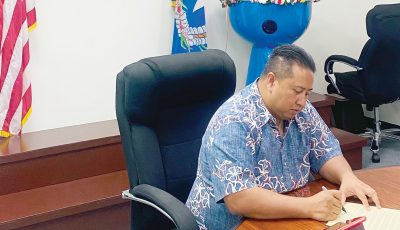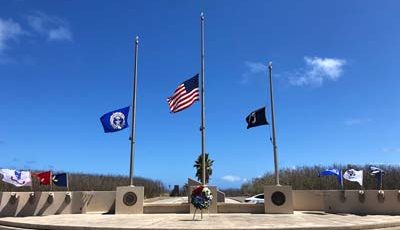‘A story of a great sacrifice’
Editor’s Note: Col. James G. Pangelinan of the U.S. Army will be delivering these remarks at the Memorial Day Service in Astoria, Illinois on Memorial Day, May 31, 2021, before members of the American Legion, the Chamber of Commerce and citizens of the city. The remarks honor and remember the American soldiers who were killed in the Battle of Saipan during World War II. It is being published here at the request of the author’s father, Ed Pangelinan
Ladies and gentlemen, distinguished guests, members of the Chamber of Commerce and American Legion, family and friends, good morning, and thank you for joining us today for this Memorial Day Service.
We’re here to honor and remember the devotion of American soldiers, sailors, airmen, and Marines throughout our country’s history who gave the ultimate sacrifice in service to our great nation. We gather to speak their names and to commemorate their courage. On this peaceful summer day we take a few hours of our busy year to reflect on the fact that the blessings of liberty that we all enjoy today were paid for by the sacrifice of great men and women who gave their lives in the last full measure of devotion.
I’d like to share with you a story of such great sacrifice. It begins with a short history lesson, but ends with a tale of courage and valor worthy of remembrance. It’s the story of how the blood, sweat, and dedication of American servicemen 77 years ago changed the world forever, and in doing so, made my life and the lives of my family possible.
My father, Edward, is from a small and beautiful island chain in the western Pacific called the Marianas. They’re about halfway between Hawaii and Japan. Today, these islands include Guam and the Commonwealth of the Northern Mariana Islands, and they form the furthest western point of the United States. Two-hundred-thirteen-thousand American citizens live there today on the islands of Guam, Saipan, Tinian, and Rota.
My father and his family are from Saipan. Today it’s a beautiful tropical destination, full of lush forests, deep-blue lagoons, farmlands, and resorts. It’s a tiny piece of land, only about 45 square miles in total, surrounded by endless ocean.
But 77 years ago, almost to this day, this little spot of paradise was the scene of some of the bloodiest fighting of the Second World War. My father and his family were living on Saipan at the time. He was 5 years old.
On Dec. 8 1941, simultaneous with their attack on Pearl Harbor, the Japanese military invaded and forcibly seized the island of Guam from the U.S., giving them total domination of all the Mariana Islands.
A few months after these attacks, the U.S. and her Pacific Theater Allies began planning the series of campaigns that would result in the unconditional surrender of Japan in September 1945. But it would take four years of some of the bloodiest fighting the world had ever seen. The war in the Pacific would cost the lives of over 160,000 American servicemembers. Another 250,000 Americans were wounded or captured throughout this theater of war.
Starting with the Doolittle Raid in April 1942, America and her allies began a remarkable series of counteroffensives in the Pacific. The number of battles that would follow in this theater are too numerous to recount, but they include unforgettable names etched into world history and onto the hearts and minds of the veterans who served there. Names like Coral Sea, Midway, New Guinea, the Solomon Islands, Guadalcanal, Burma, and the Marshall Islands. By March 1944, the stage was set for the U.S. to liberate the Mariana Islands.
On 5 June 1944, the day before the Allies would cross the English Channel on the D-Day Invasion, the U.S. 5th Fleet, carrying the 2nd and 4th Marine Divisions and the Army’s 27th Infantry Division embarked from Hawaii for the assault on Saipan. Ten days later, the historic Battle of Saipan began. The story of American heroism that followed over the next 24 days of fierce combat on the island of Saipan could fill a hundred history books. Here’s the short version:
The battle commenced on the morning of June 15 with a naval bombardment of Japanese fortifications. An estimated 32,000 enemy troops were dug in and expecting the U.S. attack. Marines and soldiers riding in daylight on hundreds of landing craft began the amphibious assault against withering enemy machine gun, artillery, and mortar fires.
By afternoon, 20,000 U.S. troops had established a foothold on the southwest corner of the island, but had suffered terrible casualties. One out of every 10 Marines and soldiers in this assault were wounded or killed.
In the days and weeks that followed, the Americans expanded the beachhead and began clearing the island inch-by-inch. Each and every Japanese pillbox, camp, and gun emplacement had to be destroyed or captured, in bitter, sometimes hand-to-hand combat. Over time, the Japanese forces began retreating to fortified positions on the high ground of Mount Tapochau, the dominant terrain feature on the north side of the island. The engagements there over the next few days were a killing ground. Fighting in dense jungle and exposed to enemy fire from the high ground, U.S. Marines dubbed the area “Death Valley” and “Purple Heart Ridge.”
Eventually, Americans pushed the retreating Japanese off the mountain, forcing them into a last-stand position on the northern point of the island. Receiving no reinforcements from their navy, Japanese forces were trapped on all slides. While most of us would expect surrender to follow, what happened next highlights how fiercely the Japanese military fought. On July 6, their commander on Saipan, Gen. Saito, ordered his remaining troops to attempt a final bayonet charge. But the attack, while devastating, ultimately failed. Saito and his naval counterpart, Adm. Nagumo committed ritual suicide.
During the last days of the fighting, more than 4,000 Japanese troops and civilians, including scores of Japanese women and children, committed suicide rather than surrender. Over a thousand jumped from a spot known as Suicide Cliff, plunging 800 feet to their deaths. By the end of the fighting the Japanese suffered a staggering 29,000 casualties.
On July 9, enemy forces were defeated, and the American Flag was raised in victory over Saipan. In the 24 days of brutal combat for the liberation of this island, Americans suffered 14,000 casualties, a 20% casualty rate. [A total of] 3,426 U.S. servicemembers gave the ultimate sacrifice on that remote island in the middle of the Pacific. They died thousands of miles from their families, their homes, and the country they loved.
Five U.S. Marines and soldiers won the Medal of Honor on Saipan, all awarded posthumously. Hundreds of Silver Stars, Navy Crosses, Purple Hearts, and awards for gallantry under enemy fire would be awarded to the 71,000 Americans that took part in the three weeks of fighting.
So what is the legacy of this ultimate sacrifice paid for by brave American Marines, soldiers, and sailors some 77 years ago? Did their deaths have meaning? And why am I asking you to remember them on this Memorial Day?
I believe the 3,500 American troops that died in combat on the Island of Saipan in 1944 changed the world forever. Their sacrifice paved the way to end the war and established a persistent peace across the Pacific that remains to this day.
Once American forces liberated Saipan, they fought to liberate the remaining Mariana Islands of Tinian, Rota, and Guam. Naval engineers carved huge airfields into the jungles of the islands. The B-29 Bomber Squadrons of the Army Air Corps were finally in a position to strike into the heart of Japan. By early 1945, the North Field Airbase on Tinian was the largest airport in the world. It would become the base that the U.S. launched the fateful Enola Gay and Bockscar B-29s in August, which dropped the atomic bombs on Hiroshima and Nagasaki, ending the war.
In the years that followed the war, the Mariana Islands became, by United Nations’ mandate, a trust territory under U.S. protection. In the great post-war peace that reigned over the newly-liberated islands of the Pacific, America did something that almost no victorious nation had ever done before. We told the people of Marianas and many other islanders across the Pacific that they could choose their own future, and America would protect them and help rebuild their lives as they did so. The people of the Marianas weren’t American citizens, but many felt they were Americans in spirit.
As a 5-year-old boy on Saipan during these fateful events in world history, my father was deeply transformed by the heroism and sacrifice of the tall American troops who liberated his island home. He told me a childhood story about the end of the fighting, which I’ll never forget. His family had fled the combat and were sheltering with 82 other civilians in caves for several terrifying weeks.
In the end, my father remembers emerging from the caves, rescued by the U.S. Marines who had fought to liberate them. As he ran out into the sunlight, my father distinctly remembers an African American Marine who was speaking with my grandfather outside the cave entrance. When the Marine saw my father approach, he put his rifle down and hugged the little boy. This Marine told my grandfather that he had a young son back in the States, and hugged my dad because he reminded him so much of his boy back at home. That moment changed my father’s life forever. This simple act of kindness by a U.S. Marine in an active war zone was transformative in the life of a little island boy…who in that moment had become an American in his heart.
Three-thousand five-hundred American troops paid the ultimate price to liberate a 5-year old Saipanese boy, who spoke no English and had never seen America. Their sacrifice made him the man he would become, and their deaths made Saipan free.
In the 1960s my father received a scholarship to attend college in the United States. He went to George Washington University and later earned a law degree from Howard University. There in Washington, D.C., he met my mother. Soon after, my parents married and returned back to the islands.
Over the next five years my father and a small group of other leaders formed the Marianas Political Status Commission. With the consent of their fellow Islanders, they embarked on a political journey unique in American history.
They created a Covenant to make the Northern Mariana Islands a Commonwealth of the United States. From 1972 to 75 they negotiated this Covenant with the U.S. government on behalf of the people of the Northern Marianas. In early 1975, the Covenant was submitted to the populace to vote on in a plebiscite, and was overwhelmingly approved. It was ratified by the U.S. Congress and signed into Public Law on March 24, 1976, by President Gerald Ford. The Covenant made all people from the Commonwealth of the Northern Marianas officially American citizens and all of the islands part of the United States. They are the first people in American history to voluntarily join the USA through peaceful political negotiation.
The Covenant was the embodiment of a dream made possible by the sacrifice of the American servicemen who liberated Saipan. My father had the honor of serving as the first Resident Representative to the United States for the Commonwealth of the Northern Marianas in our nation’s capital. The little boy, who was rescued from a cave by an American Marine, had helped to make this dream a reality.
Today 52,000 Americans call the CNMI home and, as a result of the Covenant, the U.S. now controls 240,000 square miles of the Western Pacific Ocean under its national sovereignty. The inclusion of the CNMI has expanded the cultural fabric and diversity of the United States, adding the rich traditions and proud history of the people of the Northern Marianas.
I wouldn’t be alive today without the sacrifice of those brave men who gave their lives on the island of Saipan 77 years ago. The names of these heroes are inscribed in the American Memorial Park on Saipan. My family and millions of others have benefitted greatly from the price those men paid. Our lives were transformed by their heroism and valor. The Americans who died on Saipan in service to our great nation gave the gift of liberty to generations of Americans and generations more still to come.
Their lives changed the course of the world for the better and brought peace and prosperity to our nation and to people around the world. Their example inspired me and thousands of other people of the Marianas to serve in the U.S. military. The deaths in combat of these brave men was an act of enduring selflessness. It was a gift, freely given to all of us and everyone who comes after us. Their sacrifice reverberates. It echoes and enables. It continues to bless us, and it must never be forgotten.
Today we remember this sacrifice and cherish the price of freedom paid by our fallen. They form a long and unbreakable line that stretches back from the trenches of Yorktown, to the picket lines of Gettysburg, to the beaches of Normandy and Saipan, the frozen ground of Chipyong-ni, the tall grass of the Ia Drang Valley, the deserts of Kuwait, to the streets of Baghdad. In order for a nation to be free, it must first have men and women willing to fight and if necessary to die for that freedom.
Today we raise a silent prayer to all of our fallen servicemembers over the two and a half centuries of our nation’s history. We commemorate and cherish the gift they gave us and our children. Let us today and always keep them in a sacred place within our hearts. May God continue to bless our great nation with patriots like the brave Americans who liberated Saipan. Thank you!



























